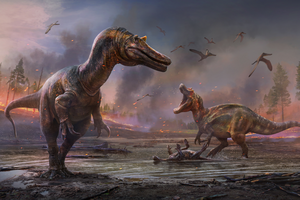This is one of several striking finds in Tanis, a unique site of fossils in the Hell Creek Formation in North Dakota (USA).

A tiny fragment of an asteroid that fell to Earth 66 millions of years ago it may have been found in amber. NASA called the discovery “amazing,” according to CNN.
moment that ended the era of dinosaurs .
The fossils found there include a fish hatched by wreckage, a stick-torn tortoise, and a limb that may have belonged to a dinosaur that witnessed an asteroid strike.
The story of the discovery is revealed in a new documentary. called “Apocalypse of the Dinosaurs”, starring naturalist Sir David Attenborough and paleontologist Robert de Palma, which airs on PBS Nova on Wednesday.
The dusty open plains contrast sharply with what this place looked like at the end of the Cretaceous. At that time, the Midwest of the Americas was a swampy rainforest, and the long-extinct inland sea, known as the Western Inland Sea Route, reached where the Gulf of Mexico now stands, to Canada.
The Tanis area, where researchers are working, is more than 2,000 miles from the Chixulub impact crater left by an asteroid that crashed off the coast of Mexico, but initial discoveries at the site have convinced de Palma that local finds are rare evidence. which led to the end of the dinosaur era.
Here are thousands of well-preserved fossils of fish that de Palma believes were buried alive when an incredible asteroid wave rushed across the sea. Unlike a tsunami, which can take several hours to reach land after an earthquake in the sea, these moving masses of water, known as seishi, instantly collapsed after a massive asteroid fell into the sea.
The scientist is convinced that the fish died literally within an hour after the asteroid hit, and not as a result of massive forest fires or nuclear winter, which occurred in the following days and months. Analysis of fish fossils also revealed the fall of the asteroid in the spring.
“One piece of evidence after another began to accumulate and change history. It was a series of pieces of evidence, as in the Sherlock Holmes investigation, “said de Palma.” .
Read also: Scientists have found traces of a tsunami from an asteroid that killed dinosaurs
Cretaceous-Paleogene extinction – one of the five so-called. “great mass extinctions”, on the verge of the Cretaceous and Paleogene period, about 66 million years ago. By the mid-2010s, further research into this issue led the scientific community to believe that an important cause of the Cretaceous Paleogene extinction was the fall of a celestial body that caused the Chikshulub crater on the Yucatan Peninsula (Mexico).




